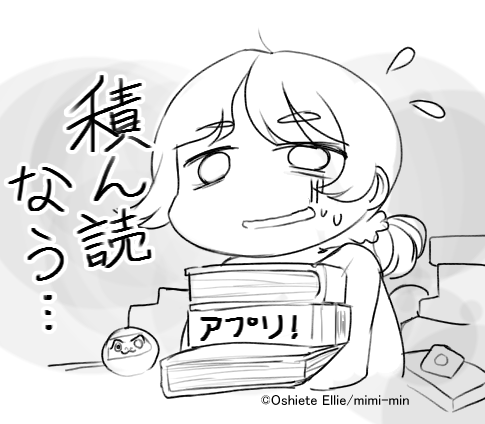Hello, everyone! How have you been lately?
I’m sorry I haven’t been updating lately! You know, school, job, life…
*talking to a wall*
But today was the first of my finals for this semester; tomorrow will be my second and final …final, and then it’s Spring Break! Which I’ve decided to spend revisiting Heisig’s Remembering the Kanji (RTK for short). I was actually studying from it when I started this blog (before school violently devoured all of my time), and thought it might be fun to have progress updates and such, along with some of my notes so it’s like we can all learn together!
![[2016-03-15 - 02;55] tsundoku nau](https://old.mimi-min.com/wp-content/uploads/2016/03/2016-03-15-0255-tsundoku-nau.png) |
| So many tools…. |
Now, the thing is, it seems like a lot of people dislike RTK, saying that it will not help you learn actual Japanese. I agree that it won’t help you learn if it’s the only thing you use. For me, I use it mainly as a tool to help me do exactly as the title suggests; remember the kanji- and as a tool, not exactly a method. I mainly use it as a general road map alongside a plethora of several other tools, where said other tools are actually where I get the more useful information.
RTK focuses mainly on producing mnemonics and quirky ways to remember a single keyword that supposedly pertains to the character, but it leaves much to be desired in the way of readings, vocabulary, and context, and unfortunately, at least in my experience, context and readings are so, so important. I find that if I have nothing to stick a character to, I’ll forget it, no matter how great of a mnemonic I find or come up with. Nine times out of ten. But I still like the way RTK is laid out… the fact that it starts simple and gives a few chunks to work with at a time, then expands on them and shows you the characters you can make with the chunks you have accumulated before introducing you to new ones just makes a lot of sense to me and actually makes learning some of the characters less intimidating. I mean, I’m not exactly sure when I’ll be using the kanji for pig iron (銑), but I sure as heck know what it’s character is comprised of (actually, I didn’t even know what pig iron was before using RTK…). I already knew about the concept of radicals, but it was difficult to remember them when a bunch were thrown at me at once… Introducing the parts first then a bunch of characters to give the radical context is much more useful and has allowed me to take them more seriously. Context really is everything.
Now, about how I use RTK, here’s a secret: I actually don’t own the book! I started using it a few months ago when the Android application was on sale for $0.99 in celebration of the new release. The application actually doesn’t have any of the famous “stories” included in it, as it’s meant to be used as a supplement to the book, but I’ve found that it’s still very useful and I actually like that I have to come up with something myself. Sure, it’s more heavy lifting, technically… but it’s also more personalized so it sticks better in the context of my mind! It does, however, provide the characters, the keywords, and the “primitive elements” (which are actually shown rather than just listed, so I’m not like “what the heck does ‘crown’ look like again….?”). Usually I go through each character, writing each one down in my notebook, along with it’s primitives and meanings. It looks something like this (note the progression of the characters):
水 water
氷 icicle
永 drop + water = eternity
泉 white + water = spring
腺 flesh + spring = gland
原 cliff + spring = meadow
願 meadow + head = petition
For each one, I come up with a little image to remember. For example, for “spring”, I think back to the Fairy Fountains in the Legend of Zelda games; they were always really pretty and glittery and had a “white” feeling, and they were called fountains but they were really more like springs. Bam.
Note that the act of actually writing them down helps to solidify them in your memory! It also gives you a quick cheat sheet when you just want a quick refresher to stave off boredom.
Then I use my handy dandy quiz application of choice (for me, it’s Obenkyo), enable that chapter for the study pool, and do a few quick run-throughs with the writing mode while the characters are still fresh in my mind. I take a quick break, grab a snack or something, then come back to my notebook and start looking through vocabulary. Obenkyo actually has a nifty feature where you can open up the kanji’s page during a quiz, allowing you to look at readings and vocabulary that use the character. And that’s exactly what I do! I then take notes; I write the character, then the readings, then 4-5 of the vocabulary that stand out most to me before moving on to the next character. I like that I can do this during a quiz, so that I can also review older characters simultaneously.
The vocabulary bit is the most important part of my study routine. Because I’ve been studying Japanese for a long time, there are quite a few words that I know and use but can never seem to remember the characters for. Then when I looked at RTK, there were a lot of characters that weren’t really clicking with me. Take for example 的 – RTK says that with a dove (白) and a ladle (勺) you get “bulls eye”. Okay, I kind of get it… my story for this is that you can have dove in a soup and it’ll hit the spot. But really, what the heck is “bulls eye” supposed to mean…? How would I ever realistically use that?
Then I took a closer look at it with Obenkyo, which states that it can be bulls eye, mark, target, etc. and can be read as テキ for the onyomi or まと for the kunyomi. I peruse the vocabulary that 的 is present in… and viola, I come across things like 目的(もくてき), a word I’m actually quite familiar with. The word means something like objective, goal etc. – and it would make sense that it’s written with an eye and a target! Then, in my class, a bunch of words appear in our readings, like 一般的(いっぱんてき), 基本的(きほんてき), 全体的(ぜんたいてき). Suddenly 的 is much more relevant!
One thing that’s important to remember is that you have to take the keywords and primitive elements very loosely. I like to talk about forgetting English in order to learn Japanese, and it’s a serious thing. The English keywords can be helpful in conjuring the concepts and ideas that the characters are supposed to represent, but if you cling to them, you’ll be thinking about it all wrong. Japanese is not English! So stop using English! When you start looking at the language like a child would, associating words with their concepts rather than more words, you’ll start tapping into your brain’s natural ability to learn languages, which is critical.
I like to think of it like just adding more words to my arsenal for communication, with the difference being the context under which they’re used. Then it’s like telling your brain that we already know how to do this; we did it in grade school when we would read novels and look up unfamiliar words in the dictionary. It’s the exact same process, so don’t overthink it!
(Disclaimer: This actually tends to lead me to accidentally throw in some Japanese words when speaking with Americans because they sometimes pop up sooner, but… they know I’m a study maniac, they understand! …I think (*´▽`*);; )
Now that I’ve gone into a rant about how I use RTK to my advantage rather than labeling it as useless/misleading and throwing it out the window, I think I’ll actually get back to studying now.
…Or maybe I’ll take a nap first… なんてね!ww
皆さん、頑張ってください!
* Edit: I’m now thinking it might have been good to touch on the fact that it’s most effective if you’re actually using the kanji and vocabulary you learn on a regular basis after you learn them, but I’ll save that for another post. I think Firefox’s Furigana Inserter has a feature that lets you ignore known kanji… I’ll have to devise a way to use this to my advantage. …In other words, I haven’t gotten to the actual use part, and still have to use the dictionary quite often… which this next two weeks is supposed to help with. I’ll see how it goes and report the results! (-‘ ω ‘-)ゞ

